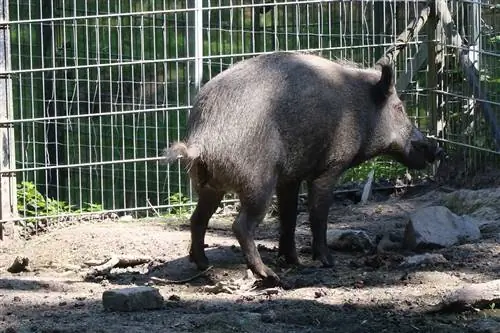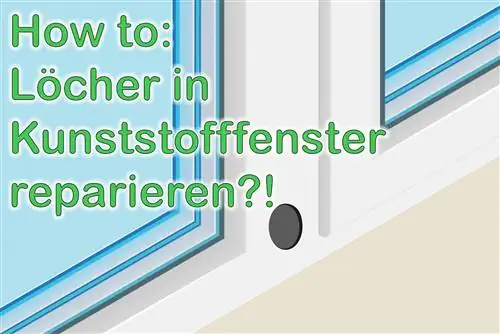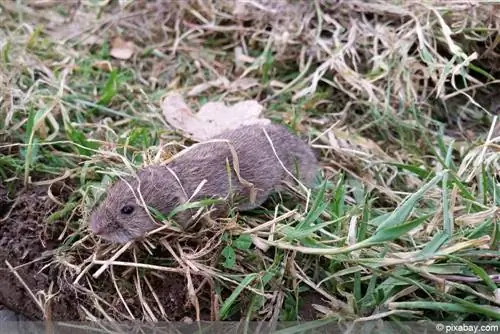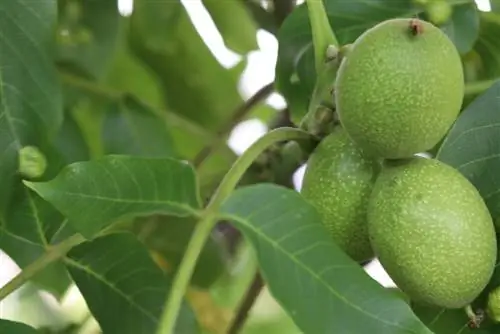- Author admin [email protected].
- Public 2023-12-17 03:39.
- Last modified 2025-06-01 06:48.
Who lives there? Garden owners ask themselves this question when holes disfigure the soil. But not only those who caused them, but above all preventative measures against the damage to the fields are welcome.
Who is digging here?
In order to identify the cause of holes in the garden, it is far from enough to find the hole and determine its size. Because the more the perpetrators are similar in body size, the more the holes are. Therefore, use various features that ultimately lead to a comprehensive picture:
- Size (diameter)
- Texture (uniform, irregular, etc.)
- Depth or presence of adjoining passages
- Presence of soil debris at or around the hole
Tip:
In addition to the actual holes, you can also collect other evidence from around the affected garden areas. Traces of feces, footprints and other remains can provide further clues to the animal species responsible
Animal species and their holes
The following animal species repeatedly cause holes in the garden. We concentrate on the holes whose size poses a real danger. In particular, tunnels and holes made by insects and worms can often be found in every garden, but they are neither noticeable nor do they interfere with the use of the garden to any significant extent.
Mice
Mice can be found in almost every type of landscape, including the garden. Above all, the widespread and well-known and feared vole poses an enormous threat, as it likes to gnaw the roots of a wide variety of garden plants from its burrows, causing them to die.
- Size: Voles around 3 to 4 centimeters, shrews and field mice approx. 2 centimeters
- Shape: uniformly round to oval
- Other characteristics: Voles often surrounded by flat mounds of earth, other mice without characteristic mounds of earth
- Occurrence: especially in outskirts with relative proximity to fields and meadows, but voles now live in a wide variety of gardens
- Preventive measures: Traps against mouse infestation, keeping cats as a deterrent or countermeasure, scented sachets with strong-smelling oils to drive away the animals
Rats
Similar to mice, rats also dig large tunnel systems, which can be recognized primarily by the entrance holes. However, they have much larger dimensions.
- Size: up to 15 centimeters
- Shape: uniformly round
- Other features: bare holes without earth ejection, further passages leading diagonally downwards
- Occurrence: especially when there is a good supply of food in the form of stored food, cultivation of crops, as well as berry and nut bushes, especially when there are sufficiently large garden plots suitable as rat territory
- Preventive measures: Keeping animals to deter (dogs, cats), scent traps to scare away, poison or mechanical traps to kill
moles
Moles are probably the most common cause of holes in popular memory. However, you can hardly ever find their holes because the animals immediately close them again after use. What remains are the consequences of the hole in the form of yielding ground and the characteristic hills.
- Size: normally no holes are visible as the animals immediately close them again
- Shape: round corridors that end in high mounds of earth
- Other features: very flexible ground due to passages leading away in the hole/hill area
- Occurrence: especially in loose soil types with a good supply of food in the form of insects, worms, etc. (good soil revitalization)
- Preventive measures: due to the protection status of the mole, only expulsion is permitted, other measures are prohibited, expulsion is similar to mice etc. through scents and regularly compacted mounds of earth (closure of the tunnels)
Wild boars
Although they obviously don't dig tunnels in the ground, wild boars can create enormous holes in the garden in their search for food in the form of worms, insects, acorns and roots.
- Size: large format to spread over large parts of the turf
- Shape: irregular, usually sprawling
- Other features: no corridors, but an almost plowed underground
- Occurrence: large, free plots of land located on the outskirts, especially near the forest
- Preventive measures: fencing, in the event of extreme infestation, targeted hunting by the responsible district tenant

Hedgehog
Hedgehogs also like to look for insects in the loose topsoil - their preferred food.
- Size: up to palm size
- Shape: very flat and round
- Other features: not very deep and rarely extends far below the turf
- Occurrence: wherever hedgehogs live or travel through, especially in well-lived areas
- Preventive measures: no measures known or required, as holes grow quickly and are harmless to garden users due to their shallow depth
NOTE:
Apart from hedgehogs, foxes and badgers can also frequently visit gardens on the outskirts of town in search of food and leave similar hole-like digs there. However, they are rather rare in private gardens, as the animals only dare to come close to urban properties in exceptional situations.
The holes are there - what now?
Whether you drive your visitors away or whether they move on voluntarily in the winter - the holes remain. The easiest way is to fill the actual holes and also the passages leading away from them with garden soil. Especially in corridors, you can first let sand trickle in, which will penetrate deeper into the subsoil due to its high self-movement. Then make sure to cover at least the top 5 to 10 centimeters with soil as a growing base. Small holes usually grow over on their own within a very short period of time. For larger holes, selective sowing of lawn seeds helps.
Tip:
So-called lawn repair mixtures use grass varieties that germinate particularly quickly and combine them with seed fertilizer and water-storing substrate additions. In this way, holes can be used to cover defects particularly safely.






